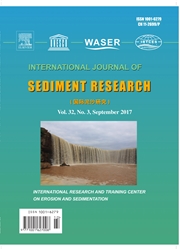

 中文摘要:
中文摘要:
在山溪流的床负担运输仔细被连接到 streambed 结构。Strambed 结构是在极端洪水期间扔的大石头和卵石的安排,在展出流动的高驱散的一种稳定的配置。领域实验在云南在一条山溪流被执行,西南的中国,三典型 streambeds 上的学习的床负担运动,即与开发的井,部分发展了,并且没有结构。一在水下观察和捕获录像的系统被设计观察并且测量床负担粒子的运动。在三个条件下面的床负担粒子的开始模式,轨道,速度,和加速被观察并且分析。结果证明床负担运动高度与 streambed 状况被联系。与开发得好的结构,床负担粒子通过跳跃间歇地移动了,床负担运输率是很低的。为部分开发的结构,大多数床负担粒子通过跳跃移动了,但是沉积的部分搬进来滑动并且滚动。在没有 streambed 结构(飞机床) 的情况中联系负担运动(滑动并且滚动) 逐渐地变得主导。而且,把压成薄片的负担运动发生了并且当流动分泌物和到来的沉积负担很高时,成为了床负担运输的主要部件。把压成薄片的负担运动是有极其高的紧张的床负担运动的一种特殊形式。两个都扮演浪费流动体力并且是的床负担运输和 streambed 结构互相抑制。床负担运输的高率在溪流发生了没有或差的床结构,和低床负担运输与很好发达的结构被联系。床负担运输率相反地被相关到 streambed 开发的度。
 英文摘要:
英文摘要:
Bed load transport in mountain streams is closely linked to streambed structures. Strambed structures are arrangements of boulders and cobbles deposited during extreme floods, in a stable configuration exhibiting high dissipation of flow. Field experiments were carried out in a mountain stream in Yunnan, southwestern China, studying bed load movement on three typical streambeds, i.e., with well developed, partially developed, and no structures. An underwater observation and video-capturing system was designed to observe and measure the movement of bed load particles. The initiation mode, trajectory, velocity, and acceleration of bed load particles under the three conditions were observed and analyzed. Results showed that the bed load movement was highly associated with streambed condition. With well-developed structures, bed load particles moved intermittently through saltation and the bed load transport rate was very low. For partially-developed structures most bed load particles moved through saltation but a portion of sediment moved in sliding and rolling. In the case with no streambed structure (plane bed) contact load motion (sliding and rolling) gradually became dominant. Moreover, laminated load motion occurred and became the main component of bed load transport when the flow discharge and incoming sediment load were very high. Laminated load motion was a special form of bed load motion with an extremely high intensity. Bed load transport and streambed structure both acted to dissipate flow energy and were mutually constraining. High rates of bed load transport occurred in the streams with no or poor bed structures, and low bed load transport was associated with well developed structures. The bed load transport rate was inversely correlated to the degree of streambed development.
 同期刊论文项目
同期刊论文项目
 同项目期刊论文
同项目期刊论文
 Rehabilitation of a debris-flow prone mountain stream in southwestern China - Strategies, effects an
Rehabilitation of a debris-flow prone mountain stream in southwestern China - Strategies, effects an Bed load transport under different streambed conditions - a field experimental study in a mountain s
Bed load transport under different streambed conditions - a field experimental study in a mountain s Least action principle, equilibrium states, iterative adjustment and the stability of river channels
Least action principle, equilibrium states, iterative adjustment and the stability of river channels Rehabilitation of a debris-flow prone mountain stream in southwestern China – Strategies, effects an
Rehabilitation of a debris-flow prone mountain stream in southwestern China – Strategies, effects an An experimental research on optimization of trajectory bucket for spillway tunnel outlet at Sanlipin
An experimental research on optimization of trajectory bucket for spillway tunnel outlet at Sanlipin The hydraulic geometry of narrow and deep channels; evidence for flow optimization and controlled pe
The hydraulic geometry of narrow and deep channels; evidence for flow optimization and controlled pe Variability of effective discharge for suspended sediment transport in a large semi-arid river basin
Variability of effective discharge for suspended sediment transport in a large semi-arid river basin 期刊信息
期刊信息
